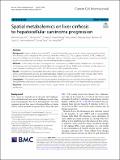Spatial metabolomics on liver cirrhosis to hepatocellular carcinoma progression
Author(s)
He, Michelle J.; Pu, Wenjun; Wang, Xi; Zhong, Xiaoni; Zhao, Dong; Zeng, Zhipeng; Cai, Wanxia; Liu, Jiayi; Huang, Jianrong; Tang, Donge; Dai, Yong; ... Show more Show less
Download12935_2022_Article_2775.pdf (9.370Mb)
Publisher with Creative Commons License
Publisher with Creative Commons License
Creative Commons Attribution
Terms of use
Metadata
Show full item recordAbstract
Abstract
Background
Hepatocellular carcinoma (HCC) is one of the deadliest cancers and is mainly developed from chronic liver diseases such as hepatitis-B infection-associated liver cirrhosis (LC). The progression from LC to HCC makes the detection of diagnostic biomarkers to be challenging. Hence, there have been constant efforts to improve on identifying the critical and predictive changes accompanying the disease progression.
Methods
In this study, we looked to using the mass spectrometry mediated spatial metabolomics technique to simultaneous examine hundreds of metabolites in an untargeted fashion. Additionally, metabolic profiles were compared between six subregions within the HCC tissue to collect spatial information.
Results
Through those metabolites, altered metabolic pathways in LC and HCC were identified. Specifically, the amino acid metabolisms and the glycerophospholipid metabolisms experienced the most changes. Many of the altered metabolites and metabolic pathways were able to be connected through the urea cycle.
Conclusions
The identification of the key metabolites and pathways can expand our knowledge on HCC metabolic reprogramming and help us exam potential biomarkers for earlier detection of the malignant disease progression.
Date issued
2022-11-24Department
Massachusetts Institute of Technology. Department of Biology; Massachusetts Institute of Technology. Department of Brain and Cognitive SciencesPublisher
BioMed Central
Citation
Cancer Cell International. 2022 Nov 24;22(1):366
Version: Final published version